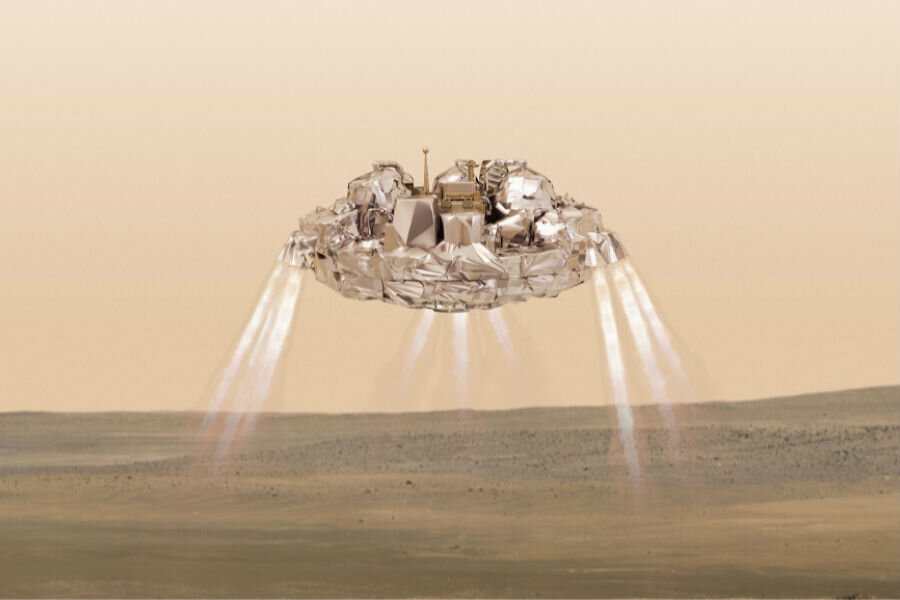Did software glitch doom the European Mars lander?
Loading...
The European Space Agency's spacecraft's primary mission was to demonstrate how well its cutting-edge landing system would deal with the treacherous descent to the Martian surface.
The Schiaparelli probe had a parachute, an advanced landing computer, and thrusters for slowing the descent onboard. But as the probe left for the surface, something went wrong. The ESA lost contact with Schiaparelli, and later images from a NASA orbiter revealed a dark impact crater and a parachute in the area where the probe was supposed to land.
The ESA's ExoMars team is still analyzing what happened to the probe. As they study the crash, they are becoming more convinced that the advanced hardware of the probe wasn't to blame, but that a software glitch destroyed the 1,272-lb. lander.
Landing on Mars is tricky for a number of reasons. Mars has a thin enough atmosphere that makes it difficult for conventional parachutes to slow a probe down enough for a soft landing. However, that atmosphere is still capable of burning up spacecraft coming in too fast towards the surface. Plus, there is a minimum 26-minute round-trip delay in signals between the craft and mission control, precluding direct Earth-based control over the probe during the descent.
The Schiaparelli solution was to deploy parachutes to slow the craft slightly, then jettison the heat shield and parachute in favor of hydrazine rockets that would slow the probe even further. The rockets would then cut out only two meters above the surface and then safely drop to the ground. All of this would be controlled by the onboard landing computer without needing any direct input from Earth.
The actual descent began as expected, until, 4 minutes and 41 seconds into the fall, the heat shield and parachute ejected early. The hydrazine rockets kicked in, but instead of burning for the planned 30 seconds, the engines deactivated after about 3 seconds. The onboard computer evidently thought that the probe was already on the surface, even switching on various instruments as if it were ready to collect data from the Martian surface. In reality, however, the probe was somewhere between 2 and 4 kilometers (1.2 to 2.4 miles) above the ground.
"My guess is that at that point we were still too high." Jorge Vago, project scientist for ExoMars, told Nature. "And the most likely scenario is that, from then, we just dropped to the surface."
The lander likely hit Mars at about 186 miles per hour.
While the landing failure is a disappointment for the ESA, it is not as big a loss as it might seem. The Schiaparelli lander was meant only to gather data on the surface for a few days. Its main goal was a test run to land on the surface of Mars as a demonstration of the landing system for the next stage of ESA's ExoMars project, a full Martian rover, which the agency still hopes to land on Mars in 2020 in conjunction with Russia's Roscosmos space agency. If the crash was indeed caused by a software malfunction rather than a significant equipment failure, that problem should be relatively easy to fix.
"If we have a serious technological issue, then it’s different, then we have to re-evaluate carefully," Andrea Accomazzo, ESA’s head of solar and planetary mission, told Nature. "But I don’t expect it to be the case."
Schiaparelli's test landing was meant to provide a way to work out the kinks in the landing system, so in a way the mission was actually successful, if somewhat more catastrophic than intended.
"There are a number of things that went right," Jonathan McDowell of the Harvard-Smithsonian Center for Astrophysics told Popular Mechanics. "They successfully navigated to the top of the Martian atmosphere, the heat shield separated correctly, the parachute – and supersonic Martian parachutes are a really tricky thing to get right – worked, the separation event of all the different pieces coming off seems to have worked. So they've ticked off three or four of the five or six pieces that are needed to make a successful descent."
And even the scientific aspect of the mission wasn't a total loss. Schiaparelli's "mothership," the more scientifically important Trace Gas Orbiter (TGO) remains successfully in orbit around the Red Planet. Its goal is to look for sources of methane on the surface of the planet. Methane is a short-lived organic compound that breaks down quickly, especially in the thin atmosphere of Mars, yet it has been detected several times on the planet. On Earth, methane is often produced from biological processes, so the ESA hopes the orbiter will be able to find out whether the replenishing source of methane on Mars comes from biology or geology.
Data from TGO is also being used by scientists to learn more about the failed Schiaparelli landing in conjunction with data from the earth-based Giant Metrewave Radio Telescope in India, according to ESA's website.
"As it is, we have one part that works very well and one part that didn't work as we expected," said Dr. Vago. "The silver lining is that we think we have in hand the necessary information to fix the problem."







